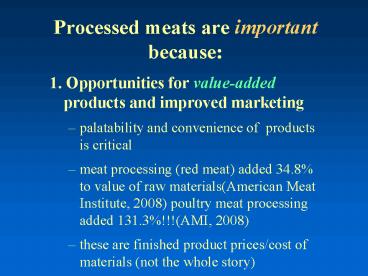Processed meats are important because: - PowerPoint PPT Presentation
1 / 51
Title:
Processed meats are important because:
Description:
i.e. grinding, chopping, tumbling, cooking, smoking, chilling. 3. ... a. fat quality (rancidity) - 'a little goes a long way' ... – PowerPoint PPT presentation
Number of Views:162
Avg rating:3.0/5.0
Title: Processed meats are important because:
1
Processed meats are important because
- 1. Opportunities for value-added products and
improved marketing - palatability and convenience of products is
critical - meat processing (red meat) added 34.8 to value
of raw materials(American Meat Institute, 2008)
poultry meat processing added 131.3!!!(AMI,
2008) - these are finished product prices/cost of
materials (not the whole story)
2
Breakdown of Hog Packers and Packer/Processors
Sales Dollar by Percent of Fresh Meat Sales
3
(No Transcript)
4
2. Great deal of science and
technology involved
- chemistry
- microbiology
- physics
- mathematics
- statistics
- engineering
- psychology
- sociology
5
3. Use information to solve problems -
great example in low-fat processed meats
- a. reduce fat ---- rubbery, hard frankfurters
- b. add water ---- purge
- c. water binders ---- dilute
- ---- increased spoilage
- d. flavoring agents
- e. antimicrobial compounds
6
(No Transcript)
7
(No Transcript)
8
(No Transcript)
9
(No Transcript)
10
(No Transcript)
11
(No Transcript)
12
- Another example is water-addedfresh
meats(moisture-enhanced)
- Salt, phosphate, lactate, diacetate
- 12 to as much as 40 water
13
(No Transcript)
14
Natural and Organic market share
- Growing rapidly
- Command premium prices
- -sliced ham (July, 2008)
- (same manufacturer)
- conventional - 1.32/100g
- natural - 1.71/100g (30)
15
(No Transcript)
16
(No Transcript)
17
(No Transcript)
18
- Safety has become a major concern(Safer
might be a better word choice.)
19
(No Transcript)
20
- Another Example
- Consumer Reports -
- on irradiated meat
21
(No Transcript)
22
Yet another example new technology
- i.e. antimicrobial ingredients, irradiation,
high pressure - Fresher Under Pressure, etc.
for ready-to-eat (RTE) meats - Listeria
monocytogenes issue
23
(No Transcript)
24
(No Transcript)
25
The meat industry is making progress on RTE
product safety but fresh meats such as ground
beef (E. coli O157H7) are still a challenge.
- less opportunity to include inhibitory treatments
26
4. Jobs / Careers
- meat as food
- maintain/improve quality, guarantee safety,
improve economies - industry is moving toward continuous control
(Q.C., HACCP, etc.) from farms through to
consumption (idiot-proofing the process) - understanding of protein functionality, spice
flavors, thermal process calculations, packaging,
laws and regulations, sanitation, shelf life
studies, human sensory panels - graduate degrees are an excellent preparation
27
5. Become a more
intelligent consumer
28
(No Transcript)
29
(No Transcript)
30
Processed meats offer
- 1. Variety
- flavor, color, shape, appearance
- more importantly ---- controlled variety,
especially from non-meat ingredients
31
2. Consumer preference / popularity
- In U.S. - 581 frankfurters are consumed per
second. This is 1,743,000 during our 50 minute
class period.
32
3. Value added
- Upgrade low value fresh meat
- major difference between fresh meat industry and
processed meat industry.
33
Processed meats are products of three things
- 1. Raw meat materials
- i.e. lean beef, fat pork,
mechanically deboned chicken - highly
variable in composition and
quality
34
(No Transcript)
35
(No Transcript)
36
2. Non-meat ingredients
- i.e. salt, spices, nitrite, soy
proteins, smoke flavoring - - provides uniqueness,
controlled variety
37
3. Physical, mechanical processes
- i.e. grinding, chopping, tumbling,
cooking, smoking, chilling
38
Notice - that these three points are what
comprise (with more specific details) your course
syllabus
39
Raw meat materials concerns
- 1. Quality - freshness
- a. fat quality (rancidity) -
- a little goes a long way
- common meat specifications is a maximum TBA
(thiobarbituric acid) number - must consider unfrozen vs. frozen meat
40
- screening for both total numbers and specific
organisms may be necessary
b. microbiological
41
- measures of performance to be expected of a meat
ingredient when used
c. Color and bind values
42
2. Composition
- biggest problem is variability
- initial concern in processing is for product
formulation - proximate composition for lean muscle is fairly
constant - water 70
- protein 20
- fat 9
- (ash 1)
- however, range is extreme
43
Reasons why formulation control is important
- 1. Economics
- protein is expensive, fat is cheap, water is free
(almost)
44
2. Quality - as perceived by consumers
- fat and sugar sell products!
45
3. Regulations
- Examples
- a. Fat content of frankfurters lt 30 and sum of
added water plus fat lt 40 (added water is water
content is excess of 4P (4 x protein content)) - i.e. frankfurter with 12 protein may be 0 -
30 fat and 48 (4P) to 88 (4P 40) water
46
b. Cured pork products - i.e. hams
- PFF (protein fat free)
- label (name) is determined by protein content
on a fat-free basis - i.e. gt 20.5 - ham
- 18.5 - 20.5 - ham with natural
juices - 17.5 - 18.5 - ham - water added
- lt 17.5 - ham and water product -
__ is added ingredients
47
c. Dried products
- MP ( moisture protein ) ratios
- dry salami 1.91
- pepperoni 1.61
- jerky 0.751
- fresh, lean meat is about 3.71
- Available water values
48
(No Transcript)
49
4. Check on finished products
- yields
- economics
- indication of change in materials or process
50
5. Competitors products
- especially useful in product development
51
- 6. Evaluation of complaints, returned products,
problems, failures































